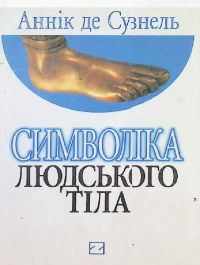The Symbolism of the Human Body (Trans. from Fr. by Zoya Borysyuk): Kyiv, Znannya-Press, 2003, 566 p.
Synopsis
Synopsis
This book is a combination of modern and archaic approaches to understanding the human body. The author sees a profound analogy between the structure of the human body and the Tree of Life in the Garden of Eden, finds symbolism of the functions of the body organs in the words of the ancient Hebrew language, reveals the unity of ancient mystical knowledge inherent in all ancient peoples and cultures, and mystical aspirations for the hidden truth. This approach allows for a deeper understanding of the human phenomenon and the search for a single source of the dictates of the mind and heart.
CONTENTS
Orthodox theologian Annick de Souzenelle
Preface
Introduction
Chapter I. The Mi and the Ma, or That Which Is Within and That Which Is Without
Chapter II. Symbols and Myths: The Symbolic Dimension of the Hebrew Language
Chapter III. From the Sword to the Tree of Life: On Good and Evil
Chapter IV. From the Tree of Life to the Sefirotic Tree
Chapter V. From the Sefirotic Tree to the Pattern of the Body
- The Body of Man, the likeness of the Body of God
- The inner and outer world in relation to Man
- The structure of the body according to the picture of the Sefirotic Tree
Chapter VI. The Two Sides of the Body; the Spinal Column
Chapter VII. Malkhut I: The Feet
- The feet of the Man is wounded
- Oedipus, or swollen foot
- Achilles, or vulnerable foot
- Jacob, or «Divine Heel». Healing of the wound
- Christ washes the feet of His apostles
Chapter VIII. Malkuth II
- Knees
- Feets
Chapter IX. Yesod, Sexuality, and Circumcision
- Circumcision
- Birth versus creation
Chapter X. The Hod - Netsah – Yesod triangle, or genitourinary plexus
- The flood
- The Exodus of the Jews to Egypt
- The labyrinth of Knossos
Chapter XI: Going through the Gate of Men
- Jacob's struggle with the angel
- The Baptism of Christ, or the reversal of energies
- The temptation of Christ in the desert. Passage through the Gate of each of us
а) Enjoyment of the Name
- b) Possession of the Name
- c) Power
- The bodily posture associated with passing through the Gates of People
- Approach to the mystery of death experienced before and after passing through the Gate of Men
Chapter XII. After Passing Through the Door of Men: the Life of the Body in the Din – Hesed – Hod – Netsah Quadrangle
- Kidneys
- Bone and blood
- Navel and heart
- Forge
а) Stomach
- b) Fire
- c) Liver
- d) Gallbladder
- e) Pancreas
- f) Spleen
- g) Heart
- h) Lungs
Chapter XIII. The Great Work: Wedding Mother Earth, or the Nigredo
- The story of Job איוב
- Jonah
- Descent into hell in Greek myths
- Hell in «Bardo-Thodöl»
- The hells of schizophrenia
- Suffering
- Descent into the Hell of Christ
Chapter XIV. Passing through the Gate of the Gods: The Albedo
- The Eagle. Arms – Shoulders – Collarbones
- Dante: paradise
- The myth of Prometheus
- False work in White, or the conquest of the Golden Fleece
- The Resurrection of Christ. The glorified body
Chapter XV. Access to the Upper Triangle: Keter-Hokhmah-Binah; the Neck; the Seven Cervical Vertebrae and the Nine Angelic Hierarchies; the Thyroid; the Medulla Oblongata
Chapter XVI: The Ear and the Tongue; Listening and the Word; the Red Phase of the Work
- The ear
- The mouth
- Saliva
Chapter XVII. The Teeth
Chapter XVIII. The Nose and Cheeks
Chapter XIX. The Eyes
- The story of Tovit
- The eye in the forehead: the emerald
- Tears
Chapter XX. The Skull
- The brain
- Cerebellum
- Forehead – Horn
- Hair and crown
Chapter XXI: The image of Christ in the oval
Conclusions
Thirty years have passed
Alphabetical index
Downloads




